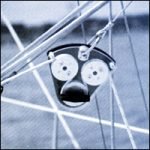Recent Dutchman Boom Brake Reviews
The Mad Dogs http://www.themaddogs.com/Equipment/Marine_gear_Deck/Dutchman_Boom_Brake.htm
The Teak Rail http://theteakrail.
Our boom brake uses three sheaves, which the line wraps around in a serpentine fashion. The upper sheaves are fixed. The lower sheave can rotate between friction plates. By adjusting the knob, more or less friction can be applied as needed. In light air, the lower sheave should rotate so the boom can come across on its own. In more wind, the knob should be tightened, locking the lower sheave.
While underway, the friction is regulated by adjusting the tension on the brake line. To hold the boom in place, tighten the brake line. To allow a jibe, just ease off on the brake line. In time, you will get a good feel for how much tension is required.
You must be able to adjust the tension on the brake from the cockpit. Either run the brake line along the toerail back to a cockpit winch, or pull the brake up towards the boom using a wire pennant attached to a block and tackle. The tail of the block and tackle is run back to the cockpit from the base of the mast. In either case, it helps to have a separate vang to prevent the boom from rising when the brake is released. The brake is normally installed aft of a rigid vang.
The Dutchman Boom Brake Eliminates Accidental Jibes
Even in moderate winds on smaller boats, the force of the boom when jibing can be deadly, let alone the potential for rig damage. Although inexperienced crew or guests are especially at risk, knowledgeable sailors have also been killed or injured in jibing accidents. If you want to sail downwind without worrying or having to set up a preventer, the Dutchman Boom Brake is for you.
Our boom brake uses the same principle as a line wrapped around a winch to control side-to-side boom movements. Under tension, the boom brake works like a preventer. Ease the tension, and the boom swings at a slow, controlled rate. With the tension off, there is no effect on the boom’s movement, and tacking upwind is not affected. No more near misses, or worse, because the boom never has a chance to speed up to dangerous velocities.
Previous Brakes
The “Dutchman” works with conventional or full-batten sails, and can be easily retrofitted to an existing main. Previous models were basically a drum that the line wrapped around it. Models with grooved drums tend not to override and jam, but are expensive. Models with flat drums can jam. They also allow the line to flatten under load, increasing the contact area and amount of friction which makes them hard to control. To quote the Practical Sailor (January 1, 1994), “The Heinson, the least expensive of the three, was the most difficult to obtain the correct amount of friction.”
Convenient to Adjust
A clear-sided plate in place of an aluminum side allows you to see the two upper fixed sheaves, and the lower rotatable sheave controlled by a tension knob.With any drum-type brake, the only way to adjust the maximum amount of friction is to take off or add a wrap of line around the drum. Naturally, this is inconvenient to do this, since it means unfastening and re-running the brake line.
Tensioning
The brake can also be tensioned by a wire pennant attached to a block and tackle, if it’s easier to run a line back to the cockpit from the base of the mast. Note the separate vang attached to the becket on the wire block.
Where It Goes
The boom brake attaches directly to the boom. The line runs down to a turning block close to the chainplates, then aft to the cockpit along the toe rail. Note the separate vang forward of the brake.
Quality Construction
The brake is carefully machined of 6061 marine grade aluminum, then hardcoat-anodized. Fasteners are recessed and/or isolated. Even the shackle can be side or front mounted for easier installation. It’s a beautiful piece of gear built to last.
Easy Jibes
After you get used to how much tension is needed, simply change course, ease the brake line a little if needed, and let the boom come over on its own at a nice, controlled speed. No need to pull in the mainsheet. No More Worrying There are few jobs as uncomfortable as having to switch a preventer before a jibe, with the boom no longer under control. Why worry about an accidental jibe or risk going forward in bad weather? With a brake, the boom is always controlled and you stay in the cockpit. Plus, the brake will allow the boom to move if it hits the water, so it’s safer for your rig than a preventer.
Reasonably Priced
We work hard to keep our prices reasonable. To quote the Practical Sailor (January 1, 1994), “The Dutchman, by virtue of its two tensioning mechanisms, probably works in a somewhat wider variety of wind conditions. And at nearly half the price of the mid-size Walder, we think it’s the best choice.”
Satisfaction Guaranteed
Like all our products, the Boom Brake carries a 5-year warranty. Your satisfaction is guaranteed. See our Warranty for more details.
